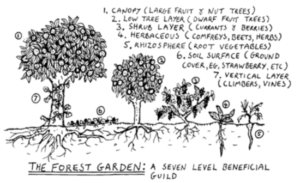Princeton High School and Princeton Middle School in a matter of a few years will be connected by the overarching branches of the tallest trees in a new multi-layer food forest now in the planning stages.
From a piece on food forests by Joanna Chin:
Robert Hart, a pioneer of forest gardening in the UK, had a vision of forest gardening:
“Obviously, few of us are in a position to restore the forests. But tens of millions of us have gardens or access to open spaces such as industrial wasteland, where trees can be planted and if full advantage can be taken of the potentialities that are available in heavily built up areas, new city forests can arise…”Through Hart’s observations of the complex relationships and interactions in his woodland forest garden, he developed a 7-layered model of forest gardens.
Food forests integrate and draw from the disciplines of permaculture, agriculture, ecology, biology and other natural living sciences. Together, these disciplines create a living set of tools and practices that can help us engage in regenerative garden design at multiple scales. A diverse community of life can grow in a small space, which is suitable for urban environments.
“Biophilia” developed by the late professor of social ecology, Stephen Kellert, suggests that humanity’s innate connection to nature transcends our physical and material reliance on the natural world. Food Forests can regenerate urban spaces through sustainable food production. And at a deeper individual level, the practice of food forestry can help us cultivate ourselves, and transform the ways in which we see and live in the world.
The “emerald necklace” is in homage to Frederick Law Olmsted, the country’s first professional landscape architect. More:
The Emerald Necklace is a winding network of green spaces that stretches across Boston. Not only do these verdant expanses serve as surprisingly lush urban oases, each of the Necklace’s “jewels”—the parks within the chain—feels like its own distinctive and natural landscape. And that’s on purpose.
As you traverse the seven-mile-long series of meadows, marshlands, and roadways, you’re living out the vision of Frederick Law Olmsted. The country’s first professional landscape architect, Olmsted believed city parks should be sanctuaries from the clamor and grit of urban life, providing peaceful settings and picturesque views as a contrast to their industrial surroundings. When Olmsted successfully applied this design theory to New York’s Central Park in 1857, Boston took note, eventually hiring him in the 1870s to build not just one large park, but an entire park system.
Hart’s seven-layer food forest:
- A canopy layer that consists of tall fruit and nut trees.
- A lower tree layer of dwarf fruit and nut trees.
- A shrub layer of fruit bushes such as currants and berries.
- An herbaceous layer of culinary and medicinal herbs, companion plants, bee- and poultry- loving plants.
- A ground cover of edible plants that function as a living mulch.
- A rhizosphere layer that consists of root crops.
- A vertical layer of vines and climbers.
Others have added a mycelial layer, for a total of eight; a lake or ephemeral pond would add a ninth layer.
PPS Emerald Necklace Food Forest team members include faculty members Jim Smirk and Mark Eastburn at PHS, along with Dr. Joy Barnes-Johnson, science supervisor for grades 6-12. For more information and to volunteer on prepping, planting and maintenance days, write Tomia MacQueen, PPS Food Systems Literacy coordinator. (Forest Garden Diagram by Graham Burnet

